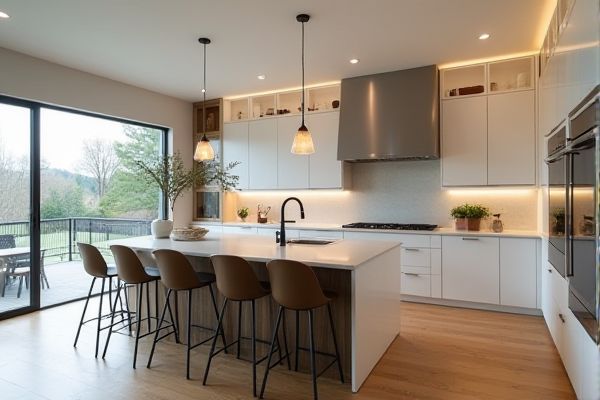
An open kitchen design enhances social interaction and creates a spacious atmosphere by integrating cooking and living areas, while a closed kitchen offers privacy and minimizes noise and odors in your home. Discover which kitchen layout best suits your lifestyle and needs by reading the full article.
Table of Comparison
| Feature | Open Kitchen | Closed Kitchen |
|---|---|---|
| Layout | Integrated with living/dining areas | Separated by walls or doors |
| Space Perception | Creates a spacious, airy feel | Defined, confined space |
| Social Interaction | Enhances communication and engagement | Limits interaction with guests |
| Noise Levels | More noise transfer | Better noise isolation |
| Odor Control | Less control, odors spread easily | Better containment of cooking smells |
| Visibility | Full visibility of kitchen activities | Hidden kitchen view |
| Cleaning and Maintenance | Requires constant tidiness due to visibility | Mess can be hidden |
| Design Trend | Modern, popular in contemporary homes | Traditional, preferred for privacy |
Introduction to Open and Closed Kitchens
Open kitchens feature an integrated layout that connects the cooking area with living or dining spaces, promoting social interaction and maximizing natural light. Closed kitchens are enclosed by walls and doors, offering privacy, noise reduction, and containment of cooking odors. Choosing between open and closed kitchens depends on lifestyle preferences, space availability, and desired kitchen functionality.
Key Differences Between Open and Closed Kitchens
Open kitchens feature a seamless flow between cooking and living spaces, promoting social interaction and a spacious feel but might compromise on noise and odor control. Closed kitchens provide a distinct separation with walls or partitions, offering privacy and containment of cooking smells, ideal for focused meal preparation. Your choice depends on lifestyle preferences, space availability, and the importance of kitchen visibility or isolation in your home design.
Design Aesthetics: Open vs Closed Kitchens
Open kitchens enhance design aesthetics by creating a spacious, airy feel that seamlessly integrates cooking and living areas, promoting social interaction and a modern look. Closed kitchens offer a more traditional, compartmentalized design that provides privacy and cleaner visual separation, ideal for those preferring a clutter-free view in the main living space. Your choice between open and closed kitchens will significantly influence the overall flow and ambiance of your home's interior design.
Space Utilization and Layout Efficiency
Open kitchens maximize space utilization by eliminating walls, creating a seamless flow between cooking, dining, and living areas that enhances layout efficiency. Closed kitchens, however, provide distinct separation that can help contain clutter and cooking odors, optimizing functionality in smaller or more compartmentalized homes. Your choice depends on how you prioritize openness versus defined zones within your living space.
Social Interaction and Entertaining Guests
Open kitchens foster social interaction by allowing hosts to engage with guests while preparing meals, creating a seamless flow between cooking and entertaining areas. Closed kitchens offer more privacy and reduce cooking odors, but can isolate the host from conversations and guests. For entertaining, open kitchens promote inclusivity and dynamic gatherings, whereas closed kitchens suit intimate settings where focus on cooking without distractions is preferred.
Cooking Experience and Functionality
Open kitchens enhance the cooking experience by fostering social interaction and allowing chefs to engage with guests while preparing meals, promoting a more inclusive atmosphere. They offer greater functionality through improved workflow and visibility, making it easier to access appliances and ingredients without barriers. Closed kitchens provide a focused environment with reduced noise and odors, ideal for elaborate cooking, but may limit social interaction and visibility during meal preparation.
Ventilation, Noise, and Odor Control
Open kitchens offer superior ventilation through increased airflow, reducing smoke and cooking odors quickly, while closed kitchens rely on mechanical ventilation systems to manage air quality effectively. Noise levels tend to be higher in open kitchens due to the lack of barriers, allowing cooking sounds to permeate living areas, whereas closed kitchens contain noise, providing a quieter environment. Closed kitchens excel in odor control by isolating cooking smells, preventing them from spreading throughout the home, in contrast to open kitchens where odors disperse more freely.
Privacy and Clutter Management
Open kitchens enhance social interaction but may reduce privacy and expose clutter to living areas, requiring consistent organization to maintain a tidy appearance. Closed kitchens offer more privacy by separating cooking mess and odors from other rooms, making them ideal for minimizing visual and auditory distractions. Your choice should balance social openness with your preference for privacy and how you manage daily kitchen clutter.
Cost Considerations and Renovation Challenges
Open kitchens generally involve higher renovation costs due to structural changes such as wall removal and the need for additional ventilation systems. Closed kitchens tend to be more budget-friendly since they retain existing walls and require fewer modifications, making them easier to renovate. Your decision should factor in these cost considerations alongside potential challenges like electrical rewiring or plumbing adjustments in both layouts.
Choosing the Right Kitchen Style for Your Home
Open kitchens create a spacious, social atmosphere by blending seamlessly with living areas, promoting interaction and natural light flow. Closed kitchens offer privacy, reduced noise, and containment of cooking odors, ideal for those who prefer a defined separation between cooking and living spaces. Understanding your lifestyle and space priorities will help you choose the kitchen style that best complements your home's function and design.
 homyna.com
homyna.com